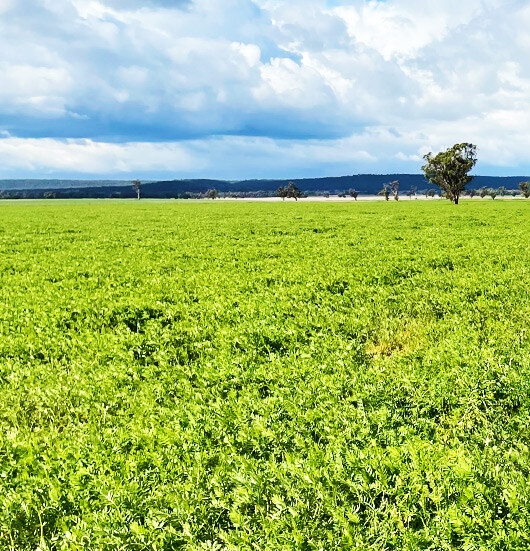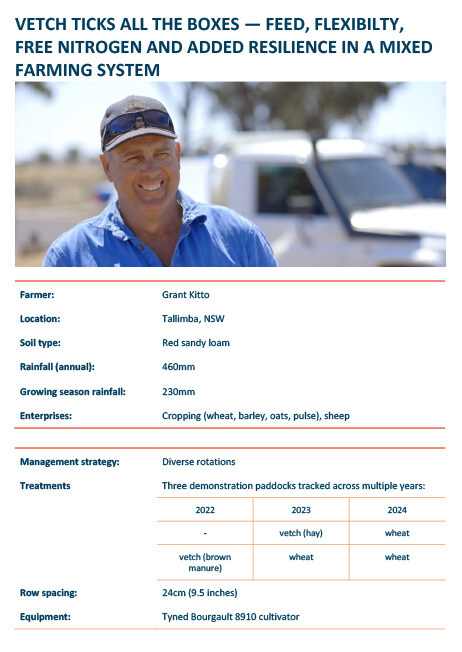Case Study: Diverse legume (pulse) rotations - vetch with Grant Kitto

Publication date
18 Nov 2024
Publication partner
This project publication is supported through funding from the Australian Government’s Future Drought Fund Drought Resilient Soils and Landscapes Grants Program and is co-funded by the Grains Research and Development Corporation.
This case study was compiled by project partner, FarmLink.
OPTIMAL SOIL AND WATER MANAGEMENT INCREASES DROUGHT RESILIENCE — FROM THE PLOT TO THE PADDOCK
Drought is an inevitable part of farming in Australia, but outcomes from the Improved drought resilience through optimal management of soils and available water project are equipping farmers with a host of additional strategies with which they can prepare for the inevitable.
Numerous small-scale field trials across southern NSW have shown that early sowing of slower-maturing crops, diverse legume rotations and nitrogen banking can all increase profitability and productivity by increasing soil moisture availability and preventing carbon and nutrient loss under drought conditions. But proving these practices are profitable on a paddock scale is key to ensuring grower adoption.
Using on-farm demonstrations, this project has demonstrated how growers can apply the theoretical strategies profitably on a paddock scale, across different soil types, environments and land uses.
Riverine Plains led this Southern NSW Drought Resilience Adoption and Innovation Hub project, in partnership with FarmLink Research, Central West Farming Systems and Southern Growers, Charles Sturt University (CSU), CSIRO and the NSW Department of Primary Industries. This collaboration saw management strategies that had been tried and tested by researchers, over six years on four sites, validated on farm with growers and advisors.
The project was supported through funding from the Australian Government’s Future Drought Fund Drought Resilient Soils and Landscapes Grants Program and is co-funded by the Grains Research and Development Corporation.
DIVERSE LEGUME (PULSE) ROTATIONS
Incorporating pulse crops into a typical wheat–canola rainfed or irrigated rotation offers long-term benefits for subsequent crops. The primary goals are to manage disease and weeds more effectively and to enhance soil health. Pulse crops fix atmospheric nitrogen, providing an immediate benefit for the current season and potentially storing nitrogen for future crops.
VETCH TICKS ALL THE BOXES — FEED, FLEXIBILTY, FREE NITROGEN AND ADDED RESILIENCE IN A MIXED FARMING SYSTEM
Case study with Grant Kitto
Location: Tallimba, NSW
Soil type: Red sandy loam
Rainfall (annual): 460mm
Growing season rainfall: 230mm
Enterprises: Cropping (wheat, barley, oats, pulse), sheep
Management strategy: Diverse rotations
Treatments: Three demonstration paddocks tracked across multiple years:
| 2022 | 2023 | 2024 |
| - | vetch (hay) | wheat |
| vetch (brown manure) | wheat | wheat |
Row spacing: 24cm (9.5 inches)
Equipment: Tyned Bourgault 8910 cultivator
AT A GLANCE
- The inclusion of vetch in the rotation has provided flexibility in a Central Western NSW mixed farming business, allowing the Kitto family to respond to fluctuations in seasonal conditions.
- As a legume, vetch is boosting soil nitrogen levels for subsequent crop growth and providing valuable weed-control options.
Vetch is ticking boxes for Tallimba, NSW farmer Grant Kitto, proving an ideal fit in his mixed farming system. The flexibility and benefits vetch offers include controlling herbicide-resistant grasses, an additional source of green feed — with the option to make hay — and an additional source of nitrogen for subsequent crops. These are just some of the key reasons Grant will continue to incorporate the legume into his rotations into the future.
“We’ve made a lot of export hay during the past 30 years and the grass-weed population was starting to build up — predominantly barley grass and silver grass. We also had some issues with herbicide resistance in our hay paddocks, so our agronomist suggested growing vetch to help us control the grasses and build up the nitrogen in our soil profile,” Grant said.
“While we haven’t got many years of data behind us yet, the visual benefits, combined with the anecdotal conversations with other farmers who have been growing vetch for several years, indicate we’re already seeing the benefits to subsequent crops.”
The Kitto family are pioneers in the region, having farmed at Tallimba since 1910. Grant’s cropping program consists of wheat, barley, oats and vetch. His rotation is six years crop followed by a 3–4 year pasture phase. He also runs 3000 Merino sheep, joining two thirds of the mob to Merino rams and one third to Dorset rams.
Prior to vetch, Grant had sown lupins as a break crop in his cropping rotation. But the flexibility and multiple feed options available with vetch in the rotation saw him make the switch from lupins to vetch in 2020.
“Vetch is a highly versatile, high-production, low-input crop. It gives us flexibility in our farming system, adding another tool to our toolkit in building resilience in our farming system” Grant said.
“It’s a high quality, high-protein feed — great sheep feed — and we’ve seen the benefits to our sheep grazing it. We had ewes and lambs on the paddock in 2022 for around eight weeks and we didn’t need to supplementary feed.”
The wet conditions in 2022 didn’t allow Grant to cut hay off the paddock, and he brown manured the crop during late September.
“With the drier 2023 season the vetch crop wasn’t as productive as the year before, but we still cut it for hay — a fairly lucrative activity — with plenty of farmers wanting to buy some. We kept some vetch on hand as a drought buffer for ourselves,” Grant said.
Not only does the vetch provide additional feed and boost soil nitrogen levels, but the option of brown manuring the crop also helps retain soil moisture during summer. Increasing profitability and productivity by increasing soil moisture availability and preventing nutrient loss under drought conditions is front and centre of farmers’ minds with the increasing fluctuations in seasonal conditions.
As part of the Improved drought resilience through optimal management of soils and available water project, Grant partnered with FarmLink to quantify the benefits of vetch in his farming system. The on-farm demonstration compared two paddocks, side by side — with varying crop rotations — as part of the larger project looking at the benefits of including legumes into cropping rotations while monitoring soil health.
THE PROOF IS IN THE DATA
The inclusion of a legume in the rotation, for hay or brown manure, increases soil moisture for the following crop, creates a break crop for weeds and disease and contributes mineral nitrogen to the system, reducing the rates of nitrogen fertiliser applications required in subsequent seasons.
Grant sowed wheat into both paddocks in 2024: paddock 1 (vetch hay followed by wheat) and paddock 2 (wheat followed by wheat). Deep nitrogen tests were taken prior to sowing in April 2024 to determine the quantity of stored moisture and nitrogen available for the following wheat crop (Table 1).
The results of the two-paddock comparison showed there was more stored moisture after the vetch hay than after the wheat crop. This extra stored moisture at depth is a result of the legume’s shorter rooting depth and a longer fallow period, in the case of hay or brown manure options.
“But it’s important to note that while we expect more stored moisture after a brown manure, the bare ground over summer can sometimes lead to poor fallow efficiency or storage of rainfall. This is due to higher evaporation rates on bare ground and reduced infiltration compared to that of wheat stubbles” James said.
TABLE 1. GRAVIMETRIC MOISTURE RESULTS (PADDOCKS 1 AND 2) 2024, TALLIMBA, NSW.#
| PADDOCK | 2023 CROP | DEPTH (CM) | GRAVIMETRIC CONTENT (%) |
| 1 | vetch (hay) | 0–10 | 11.71 |
|
1 |
vetch (hay) | 10–40 | 14.34 |
| 1 | vetch (hay) | 40–70 | 21.49 |
| 1 | vetch (hay) | 70–100 | 21.05 |
| 2 | wheat | 0–10 | 11.20 |
| 2 | wheat | 10–40 | 12.02 |
| 2 | wheat | 40–70 | 15.00 |
| 2 | wheat | 70–100 | 17.79 |
#Paddocks were sampled in April 2024.
The soil test results of the two-paddock comparison showed the vetch hay option boosted mineral nitrogen in the soil profile more than a cereal-on-cereal rotation. But nitrogen carryover was not large, which is likely due to the decision to cut the vetch for hay removing most of the above-ground biomass (Table 2).
CSIRO research supports this on-farm experience, indicating legumes leave an average of 50kg/ha more nitrogen at sowing to subsequent crops, although this range can be anywhere from 20–180kg/ha.
“The residual nitrogen story can be influenced by numerous factors, such as legume species, crop end use, including hay, brown manure or grain, how well nodulated the crop is and time of soil testing. The ongoing mineralisation through the season was likely not accounted for in the April soil test,” James said.
TABLE 2. SOIL TEST RESULTS RESULTS (PADDOCKS 1 AND 2) 2024, TALLIMBA, NSW.#
| PADDOCK | 2023 CROP | TOTAL NITROGEN (KG/HA) |
| 1 | vetch (hay) | 58.41 |
| 2 | wheat | 37.10 |
#Paddocks were sampled in April 2024 (0–70cm).
Table 3 shows the yield measurements for 2023. There appears to have been a yield and small protein benefit in the 2023 wheat crop following vetch.
TABLE 3. YIELD MEASUREMENTS 2023, TALLIMBA, NSW.
| PADDOCK | 2022 CROP | 2023 CROP | 2023 GRADE | 2023 YIELD (T/HA) |
| 1 | vetch (hay) | NA | NA | |
| 2 | vetch (brown manure) | wheat | H2 | 3.4 |
VETCH A CLEAR WINNER
To date Grant has bought vetch seed, but during 2023 he harvested 40ha for seed and is looking to continue to include vetch in his cropping program, sowing around 10 per cent of his cropping program annually to vetch.
Having the trial paddocks fronting the road, Grant has had quite a few neighbours enquiring about the vetch and the benefits he is seeing in his program.
“The biggest challenge we have had with the vetch is disease management. We had some issues in 2023 with Botrytis grey mould, so we applied fungicide twice, just before canopy closure, but apart from that the agronomy and management is simple,” Grant said.
“Like any disease-management practice, if you give some consideration to the end product — brown manuring, grazing, hay — this will determine the economic viability of the management techniques used.”
“We need reliability in our system and vetch offers us the diversity in our system to deal with whatever the seasons throw at us,” Grant said.
“Vetch allows us to graze paddocks over the winter and spring before locking them up to cut for hay or brown manuring in preparation for the following seasons crop. It provides a value-add to our mixed-farming business.”
“It also helps to build nitrogen levels in the soil for subsequent crops, and with the price of fertiliser at the moment, if we can reduce the amount of nitrogen we need to apply, I think we’re onto a good thing,” Grant said.
Resources
See more case studies and videos from the Improved drought resilience through optimal management of soils and available water project
NEWS
Discover unique perspectives on agriculture from across the Riverine Plains.
-
Livestock
-
People
-
Grains
-
Sustainability

